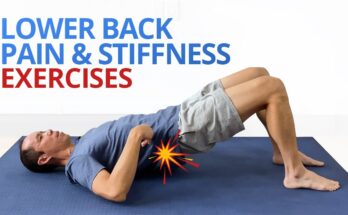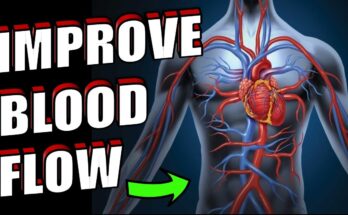Tendinitis Treatment: Tendinitis is an inflammation of the tendons, which connect muscles to bones, often causing joint pain and restricted movement.
Accurate diagnosis and effective treatment are crucial to prevent further damage and ensure a swift recovery.
Understanding Tendinitis
Tendinitis, also known as tendonitis, is a common condition characterized by inflammation or irritation of a tendon, the thick fibrous cords that attach muscle to bone. This condition often causes pain and tenderness just outside a joint. While tendinitis can occur in any of your tendons, it most commonly affects shoulders, elbows, wrists, knees, and heels.
Common Causes of Tendinitis
Tendinitis is typically caused by repetitive, minor impact on the affected area or from a sudden, more serious injury. Here are some common causes:
- Repetitive motion: Frequent and repetitive use of a particular body part can irritate the tendons leading to tendinitis.
- Age: As tendons age, they tolerate less stress, are less elastic, and are easier to tear.
- Occupation: Jobs that involve repetitive motions or forceful exertion can increase the risk of tendinitis.
- Sports: Tendinitis is often seen in people who participate in certain sports that involve repetitive movements, such as running, golf, and tennis.
Symptoms of Tendinitis
Recognizing the symptoms of tendinitis can help in seeking timely medical intervention. Common symptoms include:
- Pain: The pain from tendinitis is typically a dull ache concentrated around the affected area or joint, especially after use.
- Tenderness: The tendon and surrounding area may feel tender to the touch.
- Mild swelling: There may be slight swelling in the area, which can exacerbate the pain and tenderness.
Types of Tendinitis
There are several types of tendinitis, each affecting different parts of the body. Common types include:
- Achilles Tendinitis: Affects the Achilles tendon, which connects the calf muscles to the heel bone.
- Tennis Elbow (Lateral Epicondylitis): Occurs on the outside of the elbow and is common among tennis players and others who repetitively use their wrists or clench their fingers.
- Golfer’s Elbow (Medial Epicondylitis): Affects the inner side of the elbow.
- Rotator Cuff Tendinitis: Involves the shoulder’s rotator cuff tendons.
- Jumper’s Knee (Patellar Tendinitis): Involves the tendon that attaches the kneecap to the shinbone.
However, if you suspect you have tendinitis, consulting a healthcare provider for a proper diagnosis and appropriate treatment plan is essential. Early intervention can prevent further damage and help maintain joint health and mobility.
Diagnosing Tendinitis
Understanding when to see a doctor and the diagnostic approaches used can help in effectively managing this condition.
When to See a Doctor: Recognizing the Signs of Tendinitis
It’s crucial to consult a healthcare professional if you experience persistent or severe symptoms that suggest tendinitis. Key signs include:
- Pain at the site of the tendon and surrounding area, which may worsen with activity.
- Swelling, redness, or warmth around the affected tendon.
- A feeling of tenderness when the tendon is touched or moved.
- Restricted movement in the nearby joint.
If these symptoms don’t improve with basic home care, such as rest, ice, compression, and elevation (RICE), seeing a doctor is advisable.
Diagnostic Approaches for Tendinitis
Medical professionals use several approaches to diagnose tendinitis, ensuring an accurate assessment and appropriate treatment plan:
1. Physical Examination: The doctor will examine the affected area, checking for tenderness, swelling, and pain during movement.
2. Medical Imaging:
- X-rays: These can rule out other conditions that may cause similar symptoms, such as fractures.
- Ultrasound: This imaging helps visualize the tendon’s structure, detecting tears or inflammation.
- MRI: Provides detailed images of both soft tissues and bones, useful in complex cases.
3. Blood Tests: Sometimes conducted to rule out other conditions that could cause joint pain and swelling, such as rheumatoid arthritis.
The Role of Medical History in Tendinitis Diagnosis
A thorough medical history is vital in diagnosing tendinitis. During your consultation, the doctor will ask about:
- The onset of symptoms: Understanding when the pain or swelling started and any activities that may have triggered them.
- Previous injuries: Past injuries can predispose an individual to tendinitis.
- Occupational and recreational activities: Frequent repetitive motions can be a significant risk factor.
- Family history of musculoskeletal issues: Some conditions may have a genetic component.
However, collecting detailed medical history aids the doctor in distinguishing tendinitis from other musculoskeletal disorders and tailoring a treatment that best suits the patient’s specific needs.
Traditional Treatments for Tendinitis
This guide outlines the conventional methods used to manage tendinitis, including medications, physical therapy, and surgical options.
Medications
Medications are frequently prescribed to manage the pain and inflammation associated with tendinitis. Here is a list of common medications used:
- Nonsteroidal Anti-Inflammatory Drugs (NSAIDs): Over-the-counter NSAIDs such as ibuprofen (Advil, Motrin) and naproxen (Aleve) are often the first line of treatment. These medications help reduce inflammation and alleviate pain.
- Corticosteroids: In some cases, corticosteroid injections may be administered directly into the tendon sheath to provide rapid relief of inflammation and pain. However, these are used with caution as they can weaken the tendon over time.
- Topical Treatments: Gels, creams, and patches that contain pain-relieving or anti-inflammatory medications can be applied directly to the skin over the affected tendon.
- Pain Relievers: Acetaminophen (Tylenol) may be recommended to help manage pain, although it does not treat inflammation.
Physical Therapy
Physical therapy plays a crucial role in the treatment of tendinitis by strengthening and stretching the affected tendons and muscles, thus promoting healing and preventing further injury. Key components of physical therapy for tendinitis include:
- Stretching Exercises: These exercises help to improve flexibility and reduce tension in the tendons.
- Strengthening Exercises: Gradually strengthening the muscles around the tendon helps to reduce the load on the tendon itself.
- Ultrasound Therapy: A therapist might use ultrasound waves to promote healing by increasing blood flow and warmth in the tendon.
- Icing and Heat Application: Alternating between ice and heat can help to reduce inflammation and soothe pain.
Surgical Options
Surgery is considered when other treatments fail to relieve symptoms, and the quality of life is significantly affected. Surgical treatments for tendinitis might include:
- Tendon Repair: This procedure involves surgical removal of damaged tendon tissue and repair of any tears.
- Tendon Release: Surgery may be necessary to cut around the tendon to reduce tension and pressure.
- Tendon Debridement: This involves cleaning the tendon, removing damaged or inflamed tissue, which can relieve pain and improve function.
In summary, traditional treatments for tendinitis include a combination of medications, physical therapy, and possibly surgical intervention if other methods prove ineffective.
Advanced Tendinitis Treatment Techniques
Fortunately, advancements in medical science have led to the development of innovative treatment techniques that promise more effective and faster recovery. Here, we explore the latest advancements, the role of technology, and alternative therapies in tendinitis treatment.
Latest Advancements in Tendinitis Treatment
- Platelet-Rich Plasma (PRP) Injections: PRP therapy involves injecting a concentration of a patient’s own platelets directly into the affected tendon. This promotes natural healing by releasing growth factors that help regenerate tissue and alleviate pain.
- High-Intensity Laser Therapy (HILT): HILT uses high-energy light to reduce pain and inflammation while stimulating healing in the tendon tissues. This non-invasive technique is gaining traction for its quick results and minimal side effects.
- Ultrasound-Guided Procedures: These procedures use ultrasound imaging to guide injections, such as corticosteroids or hyaluronic acid, with precision. This accuracy helps in significantly reducing the discomfort and increasing the effectiveness of the treatment.
- Extracorporeal Shockwave Therapy (ESWT): ESWT involves sending shockwaves to the affected area to stimulate healing. It’s particularly effective for chronic tendinitis and can help avoid the need for more invasive treatments.
Role of Technology in Tendinitis Treatment
- Wearable Technology: Devices like smartwatches and fitness trackers can monitor the strain on tendons during various activities, helping patients and healthcare providers manage recovery more effectively.
- Telemedicine: Virtual consultations and follow-ups make it easier for patients to receive timely care without the need to travel, which is especially beneficial during the initial painful stages of tendinitis.
- 3D Printing: Custom-made supports and braces can now be 3D printed to fit an individual perfectly, providing targeted support to the affected tendon and improving the alignment during the healing process.
Alternative Therapies for Tendinitis
- Acupuncture: This traditional Chinese medicine technique has been adapted to help reduce pain and inflammation in tendon areas by stimulating the body’s natural painkillers and increasing blood flow.
- Herbal Remedies: Supplements such as turmeric, ginger, and omega-3 fatty acids are known for their anti-inflammatory properties and can complement conventional treatment to improve symptoms.
- Physical Therapy: Tailored exercises and stretching routines designed by physical therapists can help strengthen the muscles around the tendon, alleviating the load on the tendon and aiding in a faster recovery.
- Cryotherapy: Exposure to extremely cold temperatures can help reduce inflammation and numb pain. Cryotherapy sessions involve brief exposure to cold air or liquid nitrogen, which can be particularly soothing for inflamed tendons.
However, each of these treatments has its own benefits and may work better in different scenarios. Patients should consult with healthcare providers to determine the most appropriate approach based on their specific condition and overall health.
Home Remedies and Self-Care for Tendinitis
Here’s a guide to effective home remedies, the crucial role of rest, and the lifestyle changes that can help prevent its recurrence.
Effective Home Remedies for Reducing Tendinitis Symptoms
- Cold Compress: Applying a cold pack to the affected area for 20 minutes several times a day can help reduce swelling and relieve pain.
- Elevation: Keep the affected limb elevated above your heart whenever possible. This can also help decrease swelling.
- Compression: Use an elastic bandage or a compression wrap to help reduce swelling.
- Essential Oils: Oils such as peppermint and eucalyptus have anti-inflammatory properties that can soothe pain. However, they should be diluted with a carrier oil and tested on a small skin area first.
- Herbal Teas: Drinking anti-inflammatory herbal teas like ginger or turmeric tea can help reduce internal inflammation, supporting recovery.
Importance of Rest and Proper Care in Tendinitis Recovery
Rest is paramount in the treatment of tendinitis. Overusing the affected tendon can lead to further injury, hence:
- Avoid activities that cause pain: It’s essential to stop any activity that aggravates the condition until the pain subsides.
- Gentle stretching and strengthening exercises: Once the pain starts to decrease, gentle stretching and strengthening exercises can be beneficial. Consult a physical therapist for a suitable routine.
- Proper posture and technique: Use correct posture and techniques in your activities to avoid putting unnecessary stress on the tendon.
Lifestyle Changes and Ergonomics to Prevent Tendinitis Recurrence
Implementing lifestyle modifications and ergonomic adjustments can significantly reduce the risk of tendinitis recurring:
- Adjust your workspace: Ensure that your desk, chair, and computer setup are ergonomically designed to support proper posture and reduce strain.
- Regular breaks: Take regular breaks from repetitive tasks to stretch and change position, which can help relieve tension and stress on tendons.
- Exercise regularly: Maintaining a regular exercise routine that includes stretching and strengthening can keep tendons healthy.
- Healthy diet: Incorporate foods rich in omega-3 fatty acids, antioxidants, and proteins to support tendon health.
- Weight management: Maintaining a healthy weight can reduce the pressure on tendons, especially in weight-bearing joints like the hips and knees.
However, always consult with a healthcare provider before starting any new treatment regimen to ensure it’s safe and appropriate for your specific condition.
Prevention and Management of Tendinitis
Effective prevention and management strategies are crucial for at-risk groups and those with chronic conditions. Below, we outline targeted approaches to prevent tendinitis and offer long-term management tips, underscoring the importance of regular follow-ups.
Strategies to Prevent Tendinitis
Preventing tendinitis involves several proactive measures tailored to different at-risk groups:
- Athletes: Incorporate stretching and warming up before activities. Use proper techniques and equipment to avoid overuse.
- Office Workers and Technicians: Adjust ergonomic settings at workstations, including chair height, keyboard placement, and screen level. Take regular breaks to stretch and change posture.
- Elderly Individuals: Engage in low-impact exercises like swimming or cycling to maintain mobility without straining tendons.
- Manual Laborers: Wear supportive gear and rotate tasks throughout the day to distribute the workload evenly across different muscle groups.
By adhering to these strategies, individuals can significantly reduce their risk of developing tendinitis.
Long-term Management Tips for Chronic Tendinitis
For those suffering from chronic tendinitis, ongoing management is essential to maintain tendon health and minimize pain:
- Regular Physical Therapy: Engaging in supervised stretching and strengthening exercises can improve tendon strength and flexibility.
- Pain Management Techniques: Utilize ice packs, heat therapy, or over-the-counter anti-inflammatory medications as recommended by healthcare providers.
- Activity Modification: Alter activities to avoid movements that exacerbate tendon pain or switch to low-impact alternatives.
- Supportive Devices: Use braces or orthotic inserts as needed to reduce strain on affected tendons.
These practices help individuals manage symptoms effectively and maintain an active lifestyle despite chronic tendinitis.
Importance of Regular Follow-up and Condition Monitoring
Regular follow-ups with healthcare professionals play a pivotal role in the effective management of tendinitis. These check-ins allow for:
- Assessment of Treatment Efficacy: Healthcare providers can evaluate the success of current management strategies and make adjustments as necessary.
- Early Detection of Complications: Regular monitoring helps catch any complications early, facilitating timely interventions.
- Guidance and Education: Professionals provide ongoing guidance on exercise, ergonomics, and lifestyle adjustments to prevent further injury.
By prioritizing regular medical consultations, individuals with tendinitis can ensure they receive the most effective and up-to-date care, significantly improving their quality of life.
FAQs about Tendinitis Treatment
What is the best initial treatment for tendinitis?
The most effective initial treatment for tendinitis is the RICE protocol: Rest, Ice, Compression, and Elevation. Over-the-counter pain relievers such as ibuprofen or aspirin can also help reduce inflammation and pain.
How long does it typically take to recover from tendinitis?
Recovery time can vary depending on the severity of the condition and the affected tendon, but generally, it takes several weeks to a few months. Consistently following a treatment plan and gradually increasing activity levels as recommended by a healthcare professional are crucial for a full recovery.
Are there any effective home remedies for tendinitis?
Yes, gentle stretching and strengthening exercises can be beneficial for managing tendinitis. Applying ice to the affected area several times a day can help reduce inflammation and pain. However, it’s important to consult with a healthcare provider before starting any home treatment to ensure it’s appropriate for your specific condition.
When should I see a doctor for tendinitis?
You should consult a doctor if you experience severe pain, swelling, or redness, or if your symptoms do not improve with basic home care within a few days. Additionally, if you experience recurring bouts of tendinitis, professional assessment and treatment may be necessary to address underlying issues.
Can tendinitis lead to more serious complications?
If left untreated, tendinitis can lead to tendon rupture, which is a more serious condition requiring surgical repair. Chronic tendinitis can also lead to degenerative changes in the tendon, potentially causing persistent pain and disability. Therefore, timely and effective treatment of tendinitis is important to prevent complications.
Conclusion
In summary, tendinitis treatment encompasses a range of strategies, including rest, ice application, compression, and elevation, collectively known as the RICE protocol. Additional interventions may involve physical therapy, medications such as NSAIDs for reducing pain and inflammation, and in some cases, surgical options for severe conditions. It’s essential to tailor the treatment to the specific needs and health conditions of the individual.
While home remedies and general care can provide relief, it is crucial to consult with a healthcare professional for a proper diagnosis and comprehensive treatment plan. A specialist can offer targeted therapies and guidance tailored to your specific condition, ensuring both effective management of symptoms and prevention of further complications. Don’t hesitate to seek professional advice to navigate your recovery journey effectively. Prioritizing your health by consulting experts can lead to a quicker and safer recovery from tendinitis.
References
For those seeking additional information or wishing to validate the details provided in our discussion on tendinitis treatment, the following reputable sources are recommended. These links lead to comprehensive articles and research papers that delve deeper into various treatment methods, their effectiveness, and patient care guidelines:
- Mayo Clinic – Tendinitis Overview: Explore a detailed overview of tendinitis, including symptoms, causes, and treatment options at the Mayo Clinic’s dedicated page here.
- WebMD – Tendinitis Treatment Options: WebMD provides an extensive article on the latest tendinitis treatments and preventive tips. Read more about their recommendations here.
- American Academy of Orthopaedic Surgeons – Tendinitis: For a deeper dive into the medical perspective on tendinitis, the American Academy of Orthopaedic Surgeons offers insights on diagnosis and advanced treatment procedures. Access their resources here.
These resources are authoritative and provide a solid foundation for understanding the complexities of tendinitis and its management.



